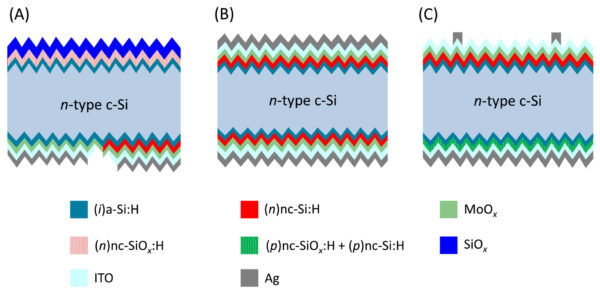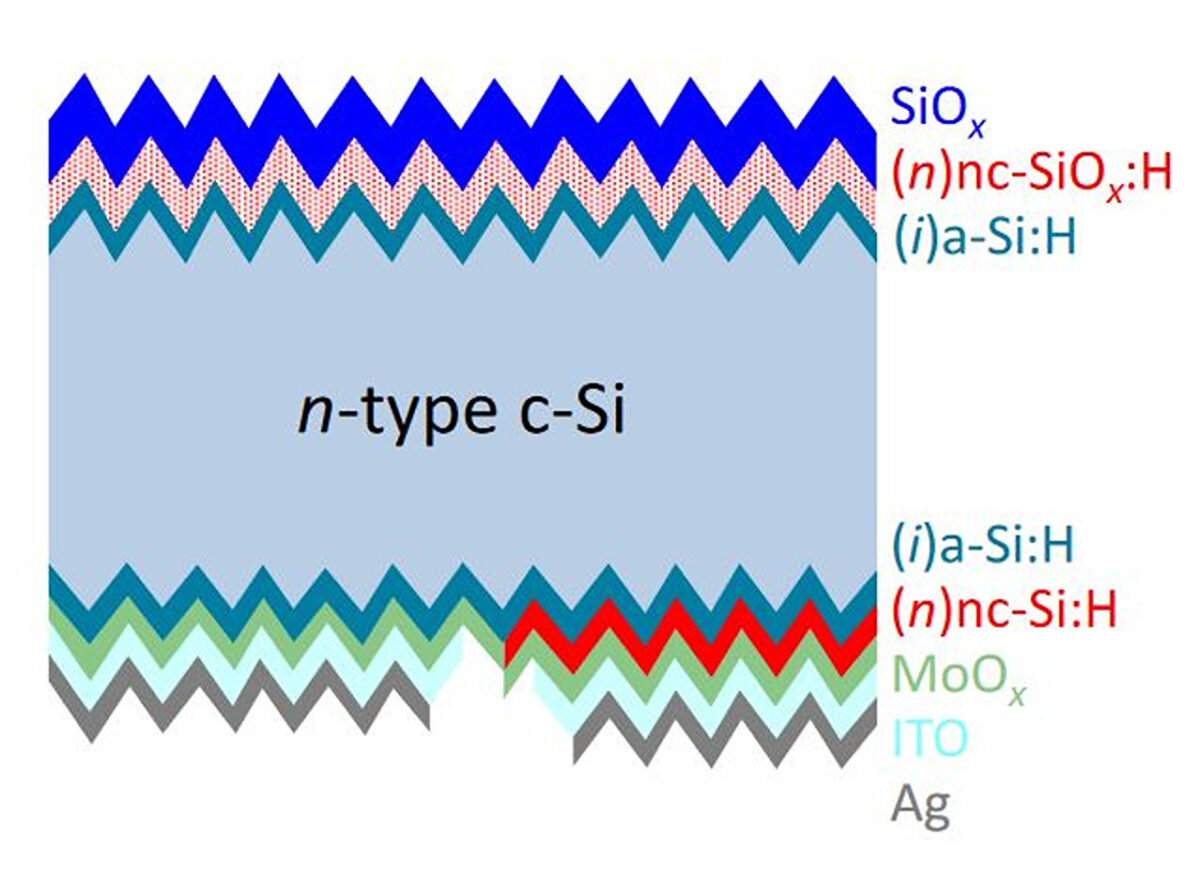Scientists at Delft University of Technology in the Netherlands have designed a solar cell with an interdigitated back contact (IBC) and heterojunction (HJT) architecture that uses an electron collection contact stack based on molybdenum oxide (MoOx).
MoOx is a transition metal oxide (TMO) nanomaterial that has both novel nanoeffects and excellent semiconductor properties.
“We demonstrate that the use of such a thin MoOx minimizes the shunting losses thanks to its low lateral conductivity while enabling the simplified fabrication process,” the research's lead author, Katarina Kovačević, told pv magazine. “In the presented structure, MoOx acts as a hole transport layer, while electron collection takes place through a novel layer stack.”
The research group explained that, in the proposed cell design, the holes are collected through a stack formed by a thin intrinsic hydrogenated amorphous silicon (a-Si:H) layer, the MoOx, and transparent conductive oxides (TCO), while electrons are collected via a blanket layer made with a-Si:H, nc-Si:H, MoOx, and TCO.
“MoOx is selected because it is characterized by lower lateral conductivity compared to doped hydrogenated nanocrystalline silicon (nc-Si:H),” the researchers stated. “In the proposed architecture, a thin MoOx layer is deposited as a blanket layer on the full rear side of the device on a pre-patterned nc-Si:H layer.”
The scientists built the cell with an indium tin oxide (ITO) substrate, the blanket layer made with a-Si:H, nc-Si:H, MoOx, an absorber made of n-type monocrystalline silicon, passivating contacts based on polysilicon and silicon monoxide (SiOx), and a silver (Ag) metal contact.

Image: TU Delft, Progress in Photovoltaics, Creative Commons License CC BY 4.0
“Besides the novel contact stack, our architecture is a great platform for testing industry-relevant processes,” Kovačević further explained. “First, Ag-free and ITO-free contacts can be easily implemented. Second, as TMOs can be deposited much faster than p-type silicon thin films, the industry can benefit from larger throughput. Third, our high-efficiency IBC solar cells can become cost-effective ingredients for future three-terminal perovskite-silicon tandem devices.”
Popular content
The research team tested the performance of a 4.05 cm2 solar cell built with this configuration under standard illumination conditions and the device was found to achieve a power conversion efficiency of 21.14%, an open-circuit voltage of 689 mV, a short-circuit current density of 39.02 mA/cm2, and a fill factor of 78.61%.
The academics attributed the good performance of the champion device to the optimization of the fabrication flowchart and precise photolithographic patterning, which they said ensured well-defined and well-passivated gaps between electron and hole collecting regions.
“Guided by optoelectrical simulations, further optimization of the fabrication process, fine-tuning of plasma treatments, MoOx and (n)nc-Si:H layer, and introduction of improved ARC(s) are expected to facilitate efficiencies well above 24% in the short run with the proposed architecture,” they added.
The novel cell architecture was introduced in the paper “Interdigitated-back-contacted silicon heterojunction solar cells featuring novel MoOx-based contact stacks,” published in Progress in Photovoltaics.
The same research group built in 2022 an HJT cell based on a MoOx hole collector. The device achieved a power conversion efficiency of 23.83% and a fill factor of 82.18%. “The certified efficiency is – to the best of our knowledge – the highest to date on this type of device,” Isabella said at the time. “The previous record was previously certified by École polytechnique fédérale de Lausanne (EPFL) at 23.5%.”
This content is protected by copyright and may not be reused. If you want to cooperate with us and would like to reuse some of our content, please contact: editors@pv-magazine.com.



By submitting this form you agree to pv magazine using your data for the purposes of publishing your comment.
Your personal data will only be disclosed or otherwise transmitted to third parties for the purposes of spam filtering or if this is necessary for technical maintenance of the website. Any other transfer to third parties will not take place unless this is justified on the basis of applicable data protection regulations or if pv magazine is legally obliged to do so.
You may revoke this consent at any time with effect for the future, in which case your personal data will be deleted immediately. Otherwise, your data will be deleted if pv magazine has processed your request or the purpose of data storage is fulfilled.
Further information on data privacy can be found in our Data Protection Policy.